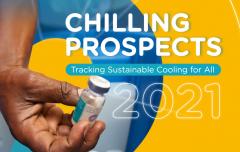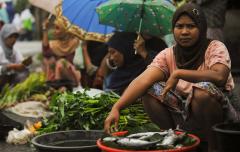Fifty million more people face heat-related risks as COVID-19 increases global cooling access challenges for the first time
- New report finds major increase in urban and rural poor populations at high risk from a lack of access to cooling, totaling 1.09 billion people.
- Asia and Sub-Saharan Africa at highest risk, with poverty impact of COVID-19 and rapidly growing hot cities contributing to increased risk.
- Access to sustainable cooling is critical to ensure nutrition, health and safety of the most vulnerable.
Vienna, 5 May 2021: In a warming world, access to sustainable cooling is not a luxury. It is essential for productivity, a healthy diet, and the delivery of COVID-19 vaccines. Today 1.09 billion vulnerable people are at high risk because they face a range of cooling access challenges. COVID-19 has intensified the situation with those forced into poverty due to the pandemic contributing to the 50 million additional urban and rural poor at high risk in 2021. Meanwhile, another 2.3 billion from the lower-middle income group face a different risk – inefficient cooling and refrigeration options that increase harmful GHG levels. Across 54 high-impact countries, 3.4 billion people face cooling access risks in 2021.
The Chilling Prospects 2021 report released today by Sustainable Energy for All (SEforALL) analyzes the four populations of urban and rural poor, lower-middle income and middle income in 54 high-impact countries, and, reveals that global cooling access risks are on the rise. This is due, in part, to the first global poverty increase seen in 20 years, impacting mostly South Asia and Sub-Saharan Africa. At the same time, 2020 was one of the hottest years on record, with numerous heatwaves recorded causing wildfires that emitted record amounts of carbon dioxide (CO₂).
“Last year was, without a doubt, a challenging one for all of us, and, as the pandemic continues, it is essential more than ever to focus our efforts on increasing energy access. Coupled with the effects of climate change, our agendas should prioritize an inclusive energy transition and deliver access to sustainable cooling to support health, economic, and social recovery, especially in areas at high risk. Together we must tackle the complexity of today's challenges and commit to achieving with great speed and scale access to clean, sustainable, and affordable energy for everyone throughout the world,” said Francesco Starace, Chair for the SEforALL Administration Board, Chief Executive Officer, and General Manager of Enel S.p.A.
The challenges and impacts on vulnerable populations
Lack of access to adequate cold chains for life-saving COVID-19 vaccines is one of the most immediate concerns facing developing countries and indeed the world. The Economist Intelligence Unit forecasts that 85 poor countries will not have widespread access to COVID-19 vaccines before 2023, including all African economies except Gabon, Egypt, Ethiopia, Kenya, Morocco, and South Africa.
“The race to achieve herd immunity against COVID-19 is revealing historical imbalances as developing countries without access to adequate cold-chains risk being left behind. This challenge will ultimately impact the social and economic recovery if left unresolved. We must collectively work to increase access to energy efficient and sustainable cooling solutions to protect against a prolonged pandemic and to support efforts to Recover Better,” said Damilola Ogunbiyi, CEO and Special Representative of the UN Secretary-General for Sustainable Energy for All and Co-Chair of UN-Energy.
Global tracking of access to cooling gaps
Chilling Prospects 2021 identifies four groups of populations at risk in the 54 high-impact countries based on a spectrum of cooling needs: human comfort and safety; agriculture, food and nutrition security; and health services and medicine.
- In 2021, the rural poor increased by 31 million to 355 million people, due to the poverty impact of the COVID-19 pandemic placing financial burdens on households and spending constraints on governments. Bangladesh, India and Nigeria had the highest number of rural poor at risk.
- The urban poor is among the fastest growing population up 19 million to 732 million people who may have sporadic access to intermittent electricity supply that can lead to food spoilage, poor nutrition and food poisoning. In 2021 this population increased by 19 million with the greatest numbers in Algeria, China, India and the Republic of Congo.
- The lower-middle income population significantly increased by about 164 million people - reversing a trend that had seen the number of at risk people in this category continually decrease since 2012. The countries most impacted include China, Guinea, Mauritania, Mozambique, Namibia, Senegal, Somalia, South Sudan, and Sri Lanka.
- The middle-income population saw a decrease of 140 million in their numbers due to the economic impact of COVID-19. This decrease negatively impacts the environment as this group is the most likely to afford efficient and greener cooling solutions. While China and India saw the greatest volume of decrease, 20 countries in Sub-Saharan Africa saw more than 10 percent decreases.
Leaving no one behind: Solutions and innovations
Chilling Prospects 2021 uses geo-spatial data and tools to identify specific pockets, such as towns or districts, that are home to populations that could be at risk. The objective is to inform and encourage policy makers to address access to cooling for populations at the highest risks.
To address this complex challenge of sustainable access to cooling, the United Nations Secretary-General issued a call in 2019 for countries to develop National Cooling Action Plans (NCAPs) that “deliver efficient and sustainable cooling and bring essential life-preserving services like vaccines and safe food to all people.” More countries are recognizing the risks caused by a lack of cooling and currently, over 20 countries are developing NCAPs.
As sustainable cooling solutions are piloted and demonstrated across the developing world, understanding these impacts is critical for governments, cities and development institutions to design policies and implement new initiatives dedicated to increasing access to sustainable cooling. Solutions piloted in different regions are yielding encouraging results.
Indonesia: The Million Cool Roofs Challenge
The Universitas Pendidikan Indonesia is applying cool roofs to homes, religious institutions, schools, and factories, and is producing important impacts for these communities of cool roofs. These sustainable passive cooling solutions are reducing indoor temperatures between 2 and 3°C in Jakarta’s low-cost housing. In an industrial building, a cool roof reduced the indoor temperature by 10°C, providing 500 workers with a more comfortable, productive workplace.
Cameroon: Youth-led solutions to vaccine and agricultural cold chain challenges
Bisolar-Tech was able to set up a high impact refrigeration project that supports 8 of 17 Sustainable Development Goals. The solar power refrigerator uses non-toxic refrigerants, achieves 45 percent efficiency provides reliable cooling for vaccines and goods in off-grid settings, and at scale could store over 360,000 vaccine doses to rural areas. This solution can also be applied to food systems and reduce energy needs for food storage, while using excess energy to power lighting and charging phones.
“By harnessing the power of these types of innovations, we can provide cooling that enhances people’s lives without contributing further to run-away climate change. As the world tries to Recover Better from COVID-19, we have seen the critical need for cooling solutions that keep vaccines safe, support the health and wellbeing of the most vulnerable, and promote prosperity,” said Brian Dean, Head of Energy Efficiency and Cooling at Sustainable Energy for All.
Chilling Prospects is produced under SEforALL’s Cooling for All initiative that is supported by the Kigali Cooling Efficiency Program, the Children’s Investment Fund Foundation, and the Swiss Agency for Development and Cooperation. The report also received contributions from the Global Panel on Access to Cooling in support of the Cooling for All Secretariat. Read the report in full here.
You can join a virtual launch of this year’s Chilling Prospects report on 5 May at 16:00 pm CET. More details can be found online here.
– Ends –
NOTES TO EDITORS
Contact
For further details on the reports or any interview requests, please contact: Sherry Kennedy, Sustainable Energy for All: Sherry.Kennedy@SEforALL.org / Media@SEforALL.org | +43 676 846 727 237
About Sustainable Energy for All
Sustainable Energy for All (SEforALL) is an international organization that works in partnership with the United Nations and leaders in government, the private sector, financial institutions, civil society and philanthropies to drive faster action towards the achievement of Sustainable Development Goal 7 (SDG7) – access to affordable, reliable, sustainable and modern energy for all by 2030 – in line with the Paris Agreement on climate. SEforALL works to ensure a clean energy transition that leaves no one behind and brings new opportunities for everyone to fulfill their potential.
SEforALL is led by Damilola Ogunbiyi, CEO and Special Representative of the UN Secretary-General for Sustainable Energy for All and Co-Chair of UN-Energy. Follow her on Twitter @DamilolaSDG7. For more information, follow @SEforALLorg.
Related content

Research
05 May 2021

Data analysis
05 May 2021

Press release
05 May 2021

Press release
05 May 2021
